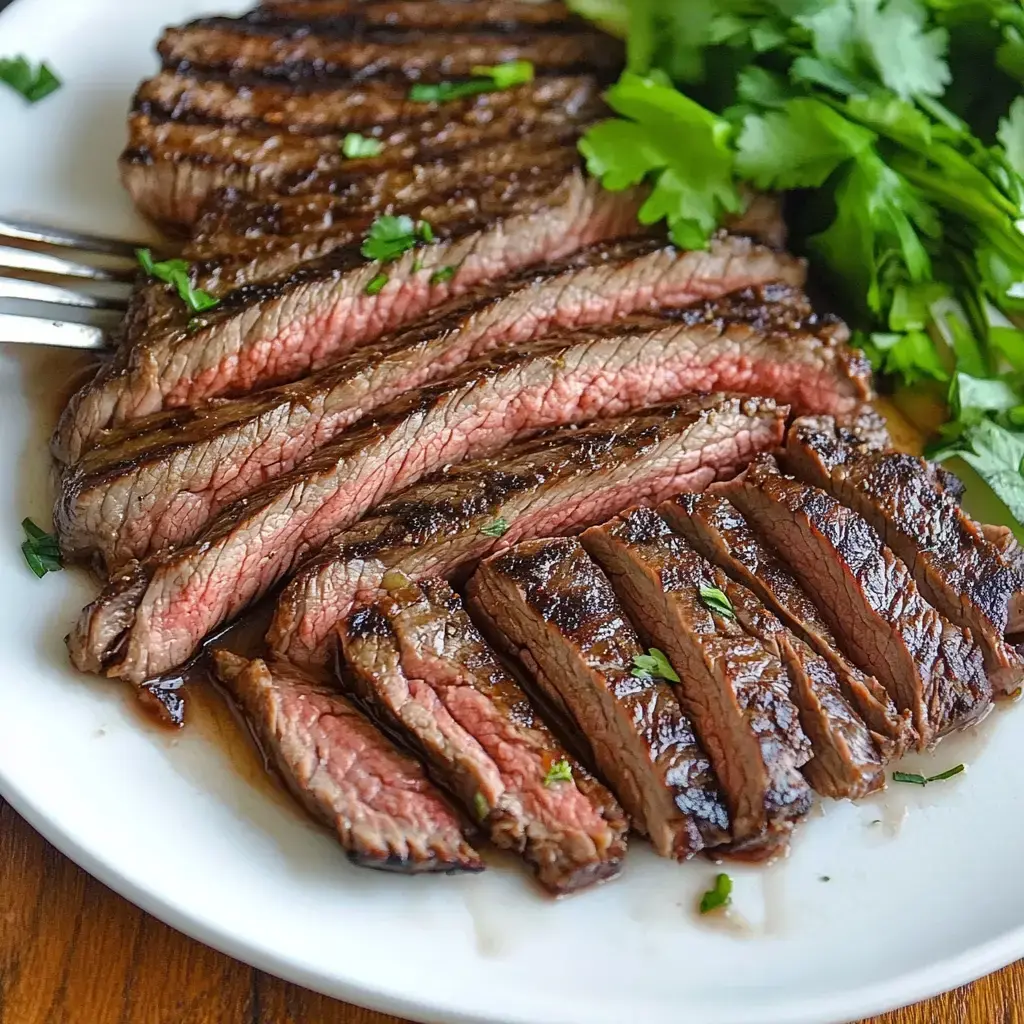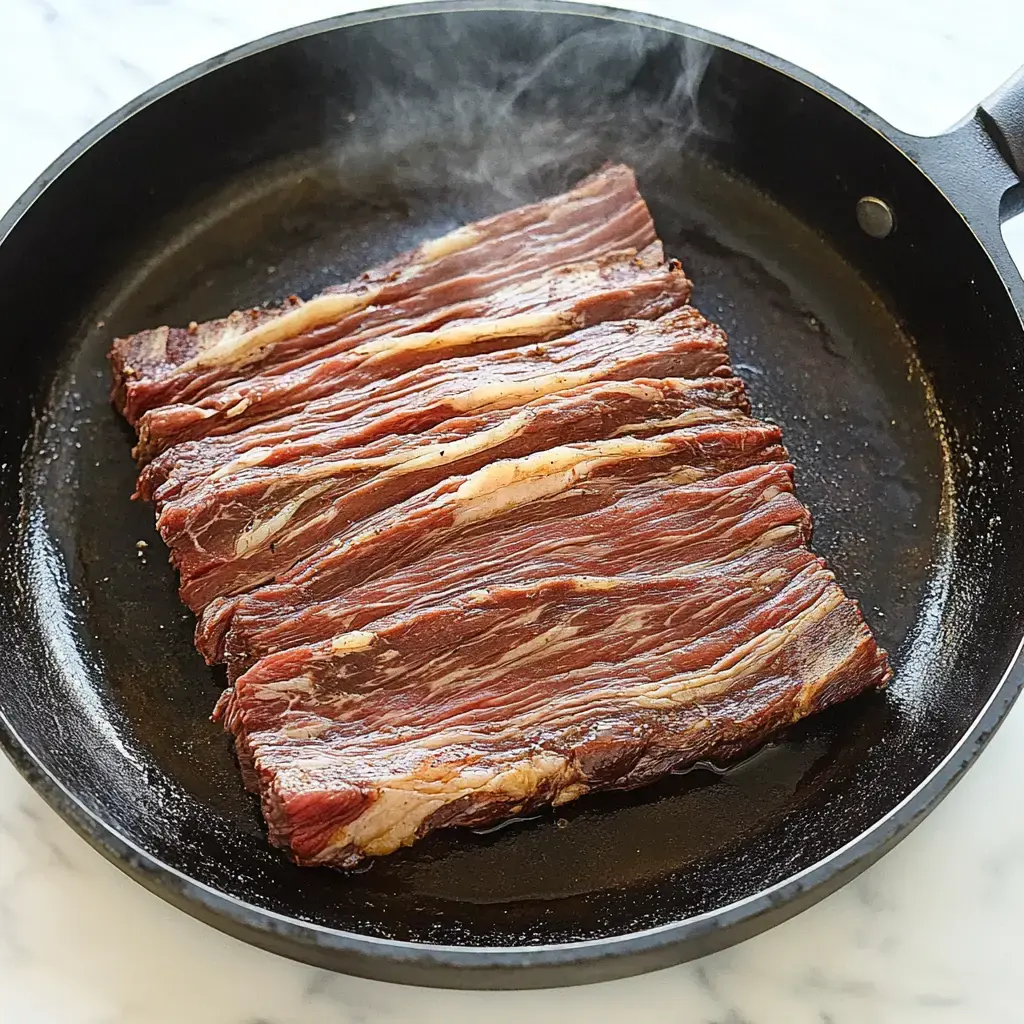 Pin it
Pin it
Looking for incredible steak without breaking the bank? A skirt steak brings knockout taste to your dinner quickly. Whether you're a cooking beginner or just checking out different beef options, getting good at skirt steak will jazz up your cooking game.
Why It Stands Out
Everyone rushes for filet or ribeye, but skirt steak delivers bigger flavor at a lower cost. Give our marinade a shot to make it even more tender. This versatile cut works in everything from salads to tacos.
Basic Ingredients
- Oil: Just enough for a good sear
- Fresh Meat: Look for nice marbling throughout
- Pepper: Grab the grinder for best results
- Salt: A healthy sprinkle of kosher salt
Cooking Steps
- Rest Before Cooking:
- Pull the steak from your fridge about half an hour before you start. If it's too long, cut into smaller 5-7 inch sections. This makes cooking more even and handling much simpler.
- Prep The Surface:
- Grab some paper towels and make sure the meat is completely dry - this step can't be skipped if you want that beautiful crust. Season both sides with plenty of salt and pepper, lightly pressing it into the meat.
- Heat Your Skillet:
- Put your largest cast iron over high heat for about 3-4 minutes until it's super hot. Add just a thin layer of oil to coat the bottom. You'll know it's ready when you see tiny smoke wisps rising.
- Sear The Meat:
- Drop your steak in carefully and listen for that immediate sizzle. Push down slightly so all parts touch the hot surface. Let it cook about 3-4 minutes until dark brown, flip once, then another 3 minutes for a perfect medium-rare.
- Give It Time:
- Don't skip this part - transfer your steak to a cutting board and loosely cover with foil. Wait the full 10 minutes. This lets all those tasty juices stay locked inside instead of running out.
- Cut Against Grain:
- Look for those muscle lines running through the meat. Cut across them at a slight angle, making pencil-width slices. Serve right away while everything's still warm and delicious.
Understanding the Cut
This underrated cut gets ignored by many, but skirt steak shows its true value in amazing dishes. Found beneath the ribs, it comes in two varieties: outside (naturally more tender) and inside (benefits from some tenderizing). Both deliver outstanding flavor when you cook them properly.
Cut Differences
Confused about similar cuts? Flank steak comes wider and thicker, while skirt steak runs longer, thinner and packs more intense beef flavor. They'll both work in many recipes, but our marinade pairs especially well with skirt steak's natural texture.
Nailing The Technique
Quick cooking with intense heat creates the tastiest skirt steak. Get your skillet scorching hot, sear it quickly, and don't leave it cooking too long. Aim for medium-rare to keep it juicy - about 3-4 minutes each side usually does the job.
Flavor Boosters
Mix up some olive oil, fresh garlic and herbs for an easy but effective marinade. Let it soak for just half an hour - any more might make the texture too soft. Always dry it thoroughly before cooking to get that gorgeous brown crust.
 Pin it
Pin it
Serving Suggestions
After mastering skirt steak cooking, try using it different ways. Go for thin slices in soft tacos, place it on top of a fresh salad, or pair with some roasted veggies. And don't toss leftovers - they make amazing sandwiches the following day.
Frequently Asked Questions
- → What’s the best way to cook it?
Use a really hot pan. Cook it fast on both sides. Leave it alone until a crust forms, and keep things simple with just good seasoning.
- → How do I know if it’s medium rare?
A meat thermometer is handy – aim for around 54°C inside. The middle will have a nice pink color. Let it rest before cutting, though, for best results.
- → Why bother letting it rest?
This keeps all the juices locked in. Five minutes should do the trick. Don’t rush to cut into it – you’ll taste the difference!
- → Do I need to marinade it?
You can if you’d like, but a bit of salt and pepper works just fine. A short marinade works too, but the meat shines on its own.
- → How should I cut the steak?
Slice against the grain, and go for thin pieces. A sharp knife makes it easier. Cutting this way gives you tender bites.
- → Why does mine come out tough?
Be careful not to overcook it. Pay close attention to how hot your pan is. Cut it properly and let it rest enough. Fresh, high-quality meat helps too!
- → What’s the best way to transport it cooked?
If possible, cook it where you’re going. Otherwise, keep it wrapped up and don’t slice until you’re ready. Bring a good knife along. It’s worth a little effort.
- → How can I speed this up?
Leave the steak out to warm up a bit first. Start with an extra hot pan, but don’t cook too many pieces at once. A short resting time still helps.
- → What if I’m cooking for a crowd?
Cook in batches, keeping the first steaks warm while you finish the others. Avoid overcrowding your pan. Rest each piece as you go.
- → How do I boost the flavor?
Adding garlic butter makes it richer. Fresh herbs, good sea salt, or even a squeeze of fresh lime can add a lot. Keep the beef flavor in focus, though.
- → What if my pan isn’t hot enough?
Let the pan heat up longer. Look for faint smoke signals or sprinkle a bit of water – it should sizzle. A solid, heavy pan like cast iron works best for this.
- → What if there’s too much red juice?
Cook it a little more if you need to. You can test by slicing, or just use your judgement. A bit rare is generally better than overdone, though.
Conclusion
Enjoyed this? Try cooking up a thick entrecôte next. Or give French bavette a go – both are quick and done over high heat.
